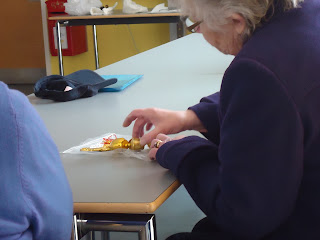| Madonna and Child tablet conserved but needing a frame for display. |
| Detail of moulding being carved |
Making things that are curved can be interesting technical challenges. The Madonna and Child tablet that has undergone conservation works is for display at Temple Newsam House. Missing its frame, a new one, of an appropriate design for the 17th century, is being made in Temple Newsam's conservation department. Starting from the tablet a template was made, and then divided into four pieces. Oak was chosen for its strength and density; softwood would be easier to carve, but because the tablet is heavy, and softwood is also prone to some movement and splitting, this makes it less than ideal for framing the sort of object we are talking about here. It is also historically accurate, oak would likely have been used in this instance, and certainly all good church and cathedral joinery is done in oak. Four pieces of quarter sawn oak were rough shaped, and their ends precisely surfaced so that the ends met cleanly. Quarter sawn oak is very straight grained, and stable. The four pieces were glued together under the pressure of a web cramp. After the glue had set a floating tenon was let in across each of the four joints. Precisely shaping the inside and outside curves was the next step. This was followed by laying out with a sharp pencil the lines of the mouldings to be carved, the carving. This was done entirely with an old hacksaw blade that I ground to make a kind of planing knife. It worked surprisingly well, and the carving was quicker than I thought it would be. Keeping the edge sharp is essential, of course. So, regularly, it is over to the diamond grit lapping stone to get an edge back, and then giving the new edge a tickle on the polishing wheel. Wicked edge achieved! Over the coming days I will update with all the procedures, because eventually this frame will be watergilded, and then toned down to give the sort of appearance of an old gilded surface.
Frame in oak being fabricated and shaped. |
| With the moulding carved and smoothed the frame is ready for the next stages. |
Onto the bare oak a coat of rabbit skin glue size is brushed on. Mixed 1 part rabbit skin glue granules to 10 parts water, and then gently heated into solution. The subsequent layers of gesso is the size in the same dilution with chalk (calcium carbonate) mixed in. More about gesso and its purpose when we get to that stage. The hot size when applied to the oak will be absorbed a long way into the timber. This will prevent excess rabbit skin glue in the gesso being absorbed into the oak. This would weaken the gesso and make it crumbly. The size also helps with bonding the gesso to the wood, forming a chemical bridge between the two. Powerful hydrogen bonding takes place between the size and the wood, and the size and the gesso, an interface between the wood and the gesso, and absorbed into both.
| Rabbit skin glue size being brushed and worked into the surface of the wood that will be gilded. |
| Powdered chalk is mixed into the size to make gesso. Enough chalk is mixed in until the gesso has the appearance and consistency of single cream. |
| The coats of bole are made extremely smooth with a succession of abrasive papers, finishing with an abrasive of at least 6000 grit. Effectively this action is polishing the bole. The surfaces are now ready to receive the gold leaf. |
Gold leaf is extremely thin. In water gilding it is bonded to the substrate by the glue in the bole and the gesso. This is re-activated with water. To help bonding further a little rabbit skin glue size is added to the water. A little ethanol (a kind of alcohol) is added too. This helps to break the surface tension of the water and helps it to wet the surface instead of beading. Gilders call this solution "size water". The gold leaf is cut to manageable, suitable, sizes and shapes with a gilder's knife. The gold is supported on a gilder's cushion at this stage, having been drawn out of the book of gold leaf it was stored in. A gilder's tip is a kind of wide, fine brush. It is used to pick the gold up. It has to be slightly sticky so that the gold transfers to the tip. I put a little Vaseline on the back of my left hand, and periodically, when the gold no longer stays on the tip, brush the tip over the Vaseline.
| Laying the gold leaf |
| Picking up gold leaf with a kind of brush called a gilder's tip |
| Size water is applied to the bole. This activates the glue in the bole, and gesso. As the water is drawn into the porous surface the gold leaf is sucked down onto the surface, and is bonded by the glue. |
| All the gold leaf down. Next step, after the gilding has dried, is to dust off the excess, and then burnish the two round mouldings.
|
| The frame has been toned down with some coats of weak size with black and brown watercolour mixed in. This is very effective in giving an aged appearance, taking down the very bright, new gold without detracting from its lustre. Ready for installation by Temple Newsam's technicians. Fait accompli! Posted by Ian Fraser |















.png)




